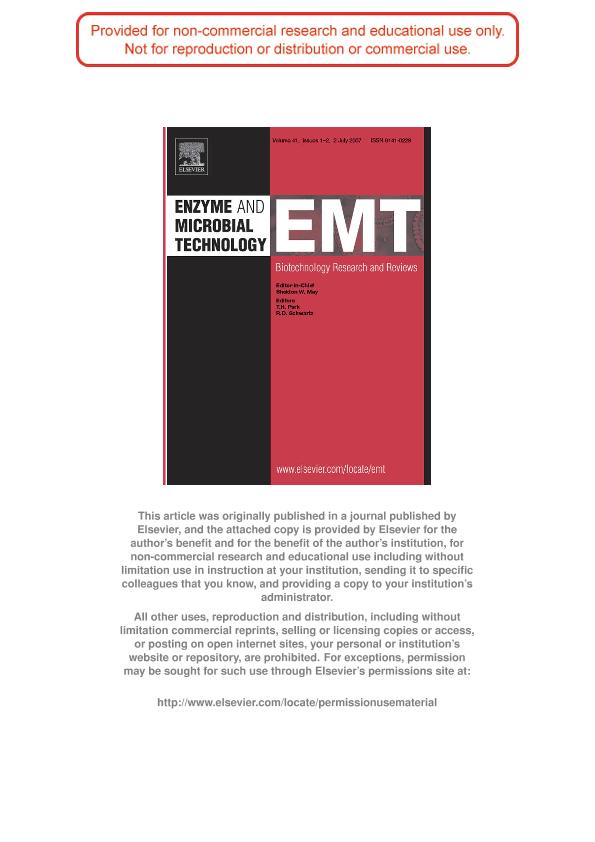Mostrar el registro sencillo del ítem
dc.contributor.author
Foresti, María Laura

dc.contributor.author
Pedernera, Marisa Noemi

dc.contributor.author
Bucala, Veronica

dc.contributor.author
Ferreira, María Luján

dc.date.available
2018-08-14T16:59:15Z
dc.date.issued
2007-07
dc.identifier.citation
Foresti, María Laura; Pedernera, Marisa Noemi; Bucala, Veronica; Ferreira, María Luján; Multiple effects of water on solvent-free enzymatic esterifications; Elsevier Science Inc; Enzyme and Microbial Technology; 41; 1-2; 7-2007; 62-70
dc.identifier.issn
0141-0229
dc.identifier.uri
http://hdl.handle.net/11336/55389
dc.description.abstract
Enhancement of the catalytic activity of lipases has commonly been performed by biocatalyst modification (immobilization on hydrophobic supports, activatiFon with interfaces, pretreatment with amphiphiles, etc.). In this work, the enhancement of the reaction rates obtained in lipase-catalyzed esterifications is achieved through modification of the number of liquid phases present in the medium in which the reaction takes place. The liquid medium may be constituted by either just one liquid phase or two liquid phases. The split of the liquid phase can be controlled by manipulating the water initially added to the system. As a result of the study of the role of water on the solvent-free enzymatic esterification of oleic acid with ethanol, the addition of relatively high amounts of water showed an unexpected beneficial effect: ester yields increased in systems with high amounts of water initially added. The addition of high amounts of water to the mixture of substrates led to the generation of two-liquid phases systems, in which the fatty acid and the produced ester remained in the organic phase, the added and reaction-generated water migrated to the aqueous phase, and the ethanol partitioned between both phases. The existence of a second aqueous phase from the beginning of the reaction favored the extraction of the water generated in the reaction, with an important reduction of the water content in the organic reactive phase. As a consequence, the increase in the global water content of the reaction medium not only did not favor hydrolysis, but also increased the fatty acid conversion in the first hours of reaction. Together with the lipase hydration and equilibrium shift, effects commonly considered in the literature of lipase-catalyzed esterifications, this manuscript emphasizes another effect of water related to the formation of a two-liquid phases system. Experimental and modeling data from reactions catalyzed with up to 15 biocatalysts (native and immobilized lipases) are presented to analyze the role of water on the rate of solvent-free enzymatic esterifications.
dc.format
application/pdf
dc.language.iso
eng
dc.publisher
Elsevier Science Inc

dc.rights
info:eu-repo/semantics/openAccess
dc.rights.uri
https://creativecommons.org/licenses/by-nc-nd/2.5/ar/
dc.subject
Equilibrium Shift
dc.subject
Hydration
dc.subject
Lipase
dc.subject
Solvent-Free Esterification
dc.subject
Two-Liquid Phase System
dc.subject
Water Effects
dc.subject.classification
Otras Ingeniería Química

dc.subject.classification
Ingeniería Química

dc.subject.classification
INGENIERÍAS Y TECNOLOGÍAS

dc.title
Multiple effects of water on solvent-free enzymatic esterifications
dc.type
info:eu-repo/semantics/article
dc.type
info:ar-repo/semantics/artículo
dc.type
info:eu-repo/semantics/publishedVersion
dc.date.updated
2018-07-23T17:56:30Z
dc.journal.volume
41
dc.journal.number
1-2
dc.journal.pagination
62-70
dc.journal.pais
Estados Unidos

dc.description.fil
Fil: Foresti, María Laura. Consejo Nacional de Investigaciones Científicas y Técnicas. Centro Científico Tecnológico Conicet - Bahía Blanca. Planta Piloto de Ingeniería Química. Universidad Nacional del Sur. Planta Piloto de Ingeniería Química; Argentina
dc.description.fil
Fil: Pedernera, Marisa Noemi. Consejo Nacional de Investigaciones Científicas y Técnicas. Centro Científico Tecnológico Conicet - Bahía Blanca. Planta Piloto de Ingeniería Química. Universidad Nacional del Sur. Planta Piloto de Ingeniería Química; Argentina
dc.description.fil
Fil: Bucala, Veronica. Consejo Nacional de Investigaciones Científicas y Técnicas. Centro Científico Tecnológico Conicet - Bahía Blanca. Planta Piloto de Ingeniería Química. Universidad Nacional del Sur. Planta Piloto de Ingeniería Química; Argentina
dc.description.fil
Fil: Ferreira, María Luján. Consejo Nacional de Investigaciones Científicas y Técnicas. Centro Científico Tecnológico Conicet - Bahía Blanca. Planta Piloto de Ingeniería Química. Universidad Nacional del Sur. Planta Piloto de Ingeniería Química; Argentina
dc.journal.title
Enzyme and Microbial Technology

dc.relation.alternativeid
info:eu-repo/semantics/altIdentifier/doi/http://dx.doi.org/10.1016/j.enzmictec.2006.11.023
dc.relation.alternativeid
info:eu-repo/semantics/altIdentifier/url/https://www.sciencedirect.com/science/article/pii/S0141022906005886
Archivos asociados
